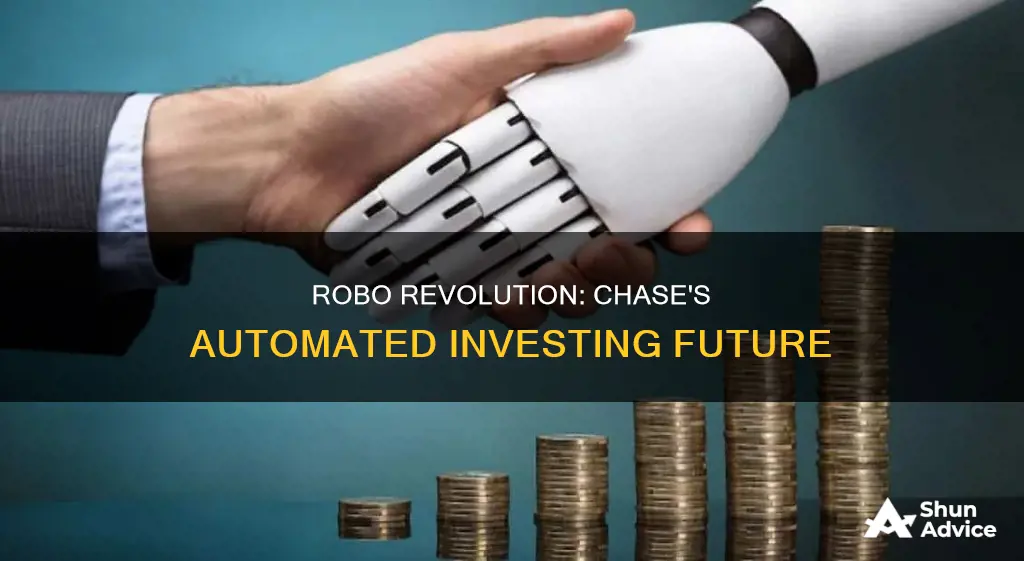
J.P. Morgan Chase & Co. has announced that it will be discontinuing its robo-advisor platform, J.P. Morgan Automated Investing, in the second quarter of 2024. The decision to shut down the platform, which was first launched in 2019, comes as a result of weak demand and a lack of profitability. Existing customers have been notified that their Automated Investing accounts will be converted to J.P. Morgan Self-Directed Investing online brokerage accounts, with investments no longer being managed by J.P. Morgan. This move highlights the challenges faced by robo advice business models, as many other major firms have also discontinued their automated investing offerings.
| Characteristics | Values |
|---|---|
| Date of robo investing roll out | July 2019 |
| Robo advisor name | You Invest Portfolios |
| Annual fee | 0.35% of assets |
| ETFs fees | Waived |
| Minimum investment | $2,500 |
| Portfolios | Conservative, Moderate, Growth, Aggressive |
| Account types | Individual and joint taxable; Traditional IRA, Roth IRA |
What You'll Learn
- Chase is discontinuing its robo-investing service in Q2 2024
- Robo-investing is being replaced by Self-Directed Investing
- The robo-investing service was only available to existing J.P. Morgan customers
- The service had a minimum balance requirement of $500
- Robo-investing is a basic service that constructs a portfolio based on a risk questionnaire

Chase is discontinuing its robo-investing service in Q2 2024
Chase is discontinuing its robo-investing service in the second quarter of 2024. The service, called J.P. Morgan Automated Investing, was a robo-advisor platform that offered a basic experience, including a professionally managed portfolio and automatic rebalancing. The annual management fee was 0.35%, which was higher than some competitors, and there were only a handful of account types available. Existing customers have been notified that their Automated Investing accounts will be converted to J.P. Morgan Self-Directed Investing online brokerage accounts, and they will be solely responsible for managing their investments.
The decision to discontinue the service was likely due to weak demand and the challenge of profitability in the robo-advisor industry. J.P. Morgan's service is the latest in a string of robo-advisor products that have been discontinued, including offerings from BlackRock, Blooom, Northwestern Mutual, and John Hancock. The high management fees and limited features of J.P. Morgan's service may have contributed to its lack of popularity, especially for those outside of the J.P. Morgan ecosystem.
The discontinuation of the robo-investing service will likely impact customers who valued the convenience and simplicity of the platform. However, there are alternative robo-advisor options available, such as Betterment and Wealthfront, which offer similar features at potentially lower costs. It is important for customers to carefully consider their needs and compare different platforms before making a decision.
The shift away from robo-investing services highlights the preference for personalized and tailored financial advice, even if it comes at a higher cost. As such, customers may also consider seeking advice from human financial advisors or investing in products with access to human advisors.
Chase Invest: Understanding Dividend Payments
You may want to see also

Robo-investing is being replaced by Self-Directed Investing
J.P. Morgan Wealth Management is discontinuing its Automated Investing program in the second quarter of 2024. The company will convert existing Automated Investing accounts to J.P. Morgan Self-Directed Investing online brokerage accounts. This means that J.P. Morgan will no longer manage the investments in these accounts, and advisory fees will not be charged. This shift from robo-investing to self-directed investing underscores the ongoing evolution of the investment landscape, driven by technological advancements and changing investor preferences.
Robo-investing and self-directed investing represent distinct approaches to investment management. Robo-investing involves automated platforms that utilize algorithms to construct, manage, and rebalance portfolios based on an individual's financial goals and risk tolerance. On the other hand, self-directed investing empowers individuals to make their own investment decisions, providing full control over the investment process.
The decision to transition from robo-investing to self-directed investing at J.P. Morgan reflects a shift in priorities and a recognition of the evolving needs of investors. By offering self-directed investing, J.P. Morgan provides its clients with greater autonomy and flexibility in managing their investment portfolios. This approach aligns with the increasing demand for personalized and tailored investment strategies.
Self-directed investing offers several advantages over robo-investing. Firstly, it provides investors with the freedom to choose and manage their own investment portfolios, allowing for a higher level of customization. Secondly, self-directed investing eliminates the management fees typically associated with robo-advisors, resulting in potential cost savings for investors. Additionally, self-directed investing enables individuals to make timely investment decisions without relying on algorithms, ensuring they can seize market opportunities promptly.
However, it is important to acknowledge that self-directed investing also comes with certain challenges. It requires a significant time investment and a solid understanding of financial markets and investment principles. Investors opting for self-directed investing need to stay updated with market trends, analyze potential investments, and make informed decisions. This level of involvement may not suit everyone, especially those with limited time or expertise in financial management.
In conclusion, while robo-investing has its advantages, such as convenience and automation, self-directed investing offers a higher degree of control and customization. The shift from robo-investing to self-directed investing at J.P. Morgan underscores the importance of adapting to the changing preferences and needs of investors. By empowering clients to take charge of their investment decisions, J.P. Morgan is providing them with the flexibility to align their investment strategies with their financial goals and risk tolerance.
Retirement Strategies: Exploring Five Smart Investment Options
You may want to see also

The robo-investing service was only available to existing J.P. Morgan customers
J.P. Morgan's robo-investing service, You Invest Portfolios, was designed to appeal to existing customers of the bank. The service was integrated into the Chase mobile app and website, which has over 50 million users in the U.S. This level of integration was intended to provide a seamless experience for Chase customers, allowing them to manage their investments alongside their other Chase financial products.
While the service offered a diverse mix of funds and automatic rebalancing, it lacked some features that were available from other robo-advisors, such as tax-loss harvesting. The robo-investing service was also limited to a small number of account types, including individual and joint taxable accounts, and traditional and Roth IRAs.
In December 2023, J.P. Morgan announced that it would be discontinuing its robo-investing service in the second quarter of 2024 due to weak demand. Existing customers were notified that their accounts would be converted to J.P. Morgan Self-Directed Investing online brokerage accounts, and they would no longer have their investments managed by J.P. Morgan.
Mortgage or Super: Where Should Your Money Go?
You may want to see also

The service had a minimum balance requirement of $500
J.P. Morgan Wealth Management has announced that it will be discontinuing its robo-advisor service in the second quarter of 2024. The service, which was first launched in 2019, was designed to attract new investors by offering a low-cost, digital investing service called You Invest Portfolios. For an annual fee of 0.35% of assets, J.P. Morgan would put users into an investment portfolio made up of the bank's ETFs. The minimum investment required for this service was $2,500, which the bank had planned to lower to $500 in 2024.
However, J.P. Morgan has stated that the robo investing business did not take off as expected and has not become profitable. As a result, the company will be transitioning existing customers to J.P. Morgan Self-Directed Investing online brokerage accounts, where their investments will be carried over and not sold.
While J.P. Morgan's robo-advisor service offered some benefits, such as a diverse mix of funds and integration with other J.P. Morgan products, it also had its drawbacks. The annual management fee of 0.35% was higher than some competitors, and the service lacked certain features such as tax-loss harvesting. Additionally, the service only offered a limited selection of ETFs, with some funds charging higher expense ratios that could limit long-term gains.
Overall, the robo-advisor service from J.P. Morgan may have been convenient for existing Chase customers, but it failed to attract enough users to become profitable. As a result, the company has decided to discontinue the service and focus on its Self-Directed and Advisor-led platforms.
Kyrgyzstan: The Next Construction Hub?
You may want to see also

Robo-investing is a basic service that constructs a portfolio based on a risk questionnaire
Robo-investing is a service that constructs a portfolio based on a risk questionnaire. This basic service is set to be discontinued by J.P. Morgan Wealth Management in the second quarter of 2024.
Robo-investing is a type of automated financial advising that has become an established practice in wealth management. The process involves the use of digital platforms and automated algorithms to provide portfolio allocation advice based on each investor's characteristics. This service is designed to be free from the biases of individual human advisors, offering a more standardised approach to investment management.
J.P. Morgan's robo-investing service, known as J.P. Morgan Automated Investing, is a basic robo-advisor experience that constructs portfolios using a diverse mix of funds. When signing up for the service, clients are asked a series of questions to gauge their risk tolerance, goals, and investment capabilities. Based on these responses, the robo-advisor categorises clients into one of four broad categories: Conservative, Moderate, Growth, or Aggressive. Each category has a preset asset allocation strategy, with the Conservative portfolio having the lowest risk and the Aggressive portfolio having the highest risk.
For example, the Conservative portfolio has an allocation of 75% fixed income and 25% stock, while the Aggressive portfolio allocates 10% to fixed income and 90% to stock. After completing the questionnaire, clients can review the suggested portfolio type and make changes if desired.
In addition to the risk questionnaire, J.P. Morgan's robo-advisor also offers integration with other J.P. Morgan products, automatic rebalancing, and a range of educational resources. However, the service has been criticised for its above-average annual management fee and lack of certain features like tax-loss harvesting.
While robo-investing can be a convenient and accessible way to construct an investment portfolio, it's important to remember that all investments involve risk. It's always recommended to conduct thorough research or consult a professional financial advisor before making any investment decisions.
Investing in People: Avoid the Wrong Ones
You may want to see also
Frequently asked questions
Chase rolled out robo-investing in July 2019.
The minimum investment required is $2,500, although the firm wanted to cut this to $500 in 2020.
Chase charges an annual fee of 0.35% of assets.
Chase's robo-investing service is called You Invest Portfolios.







